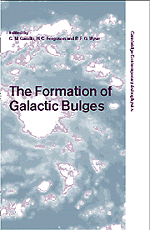Book contents
- Frontmatter
- Contents
- Preface
- Dedication: In Memory of Olin Eggen
- Part 1 Introduction
- Part 2 The Epoch of Bulge Formation
- Part 3 The Timescales of Bulge Formation
- Constraints on the Bulge Formation Timescale from Stellar Populations
- Bulge Building with Mergers and Winds
- Role of Winds, Starbursts, and Activity in Bulge Formation
- Dynamical Timescales of Bulge Formation
- Part 4 Physical Processes in Bulge Formation
- Part 5 Bulge Phenomenology
- Part 6 Conference Summary
- Index
Role of Winds, Starbursts, and Activity in Bulge Formation
from Part 3 - The Timescales of Bulge Formation
Published online by Cambridge University Press: 10 November 2010
- Frontmatter
- Contents
- Preface
- Dedication: In Memory of Olin Eggen
- Part 1 Introduction
- Part 2 The Epoch of Bulge Formation
- Part 3 The Timescales of Bulge Formation
- Constraints on the Bulge Formation Timescale from Stellar Populations
- Bulge Building with Mergers and Winds
- Role of Winds, Starbursts, and Activity in Bulge Formation
- Dynamical Timescales of Bulge Formation
- Part 4 Physical Processes in Bulge Formation
- Part 5 Bulge Phenomenology
- Part 6 Conference Summary
- Index
Summary
The starburst phase of nuclear disk evolution may not be directly related to bulge formation, but the bulge formation event itself may have been a starburst, acting at the maximum possible rate allowed by the total virial density for a few internal crossing times. Starbursts in bulges differ from those in disks because the bulge potential is too deep to allow significant self-regulation by blow-out. The total luminosity of a bulge-forming starburst is comparable to that observed in distant galaxies, when the bulges are supposed to have formed.
Starburst Models and the Formation of Bulges
If the duration of bulge formation is as short as some recent data suggest (e.g., Renzini 1999, these proceedings), then star formation in the bulge must have occurred very rapidly, perhaps in only a few internal crossing times. This implies a star formation rate of several hundred M⊙ yr−1 for less than 108 years. Such an event would be called a starburst if viewed in a primordial galaxy, so it is natural to wonder if any of the starburst regions that are observed today could be undergoing processes similar to what happened in bulges in the early Universe.
Wada, Habe & Sofue (1995) suggested that a starburst in the nuclear disk of a galaxy could generate an expanding shell of gas because of pressures from supernovae and winds. They proposed such a shell would turn into stars and mix, forming a bulge in only a few orbits.
- Type
- Chapter
- Information
- The Formation of Galactic Bulges , pp. 76 - 82Publisher: Cambridge University PressPrint publication year: 2000



